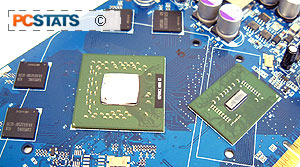 There's been a lot of focus lately on how ATi and
nVIDIA's mainstream cards only have half the rendering pipelines of their high
end counterparts. Let's remember something here though; both the NV43 and R410 have eight
pixel rendering pipelines. This is the same number as on the Radeon 9800XT, and
twice that of the GeForceFX 5950 Ultra, and those cards are still pretty fast.
There's been a lot of focus lately on how ATi and
nVIDIA's mainstream cards only have half the rendering pipelines of their high
end counterparts. Let's remember something here though; both the NV43 and R410 have eight
pixel rendering pipelines. This is the same number as on the Radeon 9800XT, and
twice that of the GeForceFX 5950 Ultra, and those cards are still pretty fast.
The GeForce 6600GT
(NV43) core is built on IBM's 0.11 micron manufacturing process, and contains
a whopping 146 million transistors. nVIDIA has cut the vertex pipelines from the
six found in the GeForce 6800 class cards to three in the GeForce
6600GT. To economize further, the memory controller has also been cut to 128bit. This means
that at high resolutions with AA/AF enabled, the NV43 will not be able to
handle the load as well as its more expensive sibling.
There are two models of the NV43 core, the GeForce
6600GT and plain GeForce 6600. The 'GT' that we're testing now has a core clock
speed of 500 MHz, and memory running at 1 GHz. The vanilla Geforce 6600 version
runs at 300 MHz core / 500 MHz memory. Both cards support all the latest DirectX
9.0C goodness as well as nVIDIA's SM (Shader Model) 3.0.
While the
core on the Albatron Trinity GeForce 6600GT AGP is SLI compatible, the
card is not since it uses an AGP interconnect. This shouldn't be much of a
surprise though. No SLI connector is present on the card for obvious reasons.
Overclocking!
While still a relatively new company in the computer world,
Albatron has built itself a strong reputation for overclocking. By default, the core
on the Trinity GeForce 6600GT videocard is clocked at 505 MHz, while the memory runs
along at 950 MHz; pretty nice numbers - but not fast enough for us!
Starting with the core, we tried to push this card to its limits. We easily
passed 550, 560 and 570 MHz core speeds before running into some problems at 580 MHz. Anything
above that speed would create artifacts while benchmarking CodeCreatures. We had to tone
things down to 578 MHz to keep it stable, which is not a bad core
overclock on... unique... stock cooling.
Albatron
has equipped the card with four K4J55323QF-GC20 Samsung DDR3 BGA DRAM modules. Seeing
that they have a 2ns rating, I was positive the memory could do 1 GHz so I
immediately raised the frequency from its stock 950MHz mark, to that number. The Samsung memory
ran at 1GHz just fine, so I continued to push on. In the end the Trinity
6600GT AGP reached 1073 MHz, definitely a nice speed bump over stock.
Happily, the Albatron Trinity GeForce 6600GT
worked just fine with both core and memory overclocked to maximum speeds, and
we were able to run through our whole set of benchmarks without slowing either
down.
 |
| PCStats Test System Specs: |
|
system 1 |
system 2 |
| processor: |
intel pentium 4 540 |
intel pentium 4 3.0c |
| clock
speed: |
16 x 200 mhz = 3.2 ghz |
15 x 200 mhz = 3.0 ghz |
| motherboards: |
gigabyte 8anxp-d, i925x |
gigabyte 8knxp, i875p |
| videocard: |
gigabyte gv-rx60x128v
gigabyte gv-nx57128d
msi
pcx5750-td128
albatron trinity pc5900
asus extreme
eax600xt
gigabyte gv-rx70p256v
gigabyte gv-nx66t128d |
ati radeon 9800xt
ati radeon 9800 pro
ati radeon
9700 pro
asus radeon
9600xt
albatron geforce 6800gt
asus v9999 gamer edition
msi nx6600gt-vtd128
msi fx5950 ultra-td128
msi
fx5900u-vtd256
msi fx5900xt-vtd128
aopen geforcefx
5900xt
albatron trinity geforce 6600gt |
| memory: |
2x 256mb crucial ballistix ddr2 |
2x 256mb corsair twinx 3200ll |
| hard drive:
|
40gb wd special ed |
40gb wd special ed |
| cdrom: |
gigabyte dvd burner |
msi x48 cd-rw/dvd-rom |
| powersupply: |
vantec stealth 470w |
vantec stealth 470w |
| software
setup |
windowsxp build 2600
intel inf 6.0.1012
catalyst
4.11
detonator 66.93 |
windowsxp build 2600
intel inf 6.0.1012
catalyst
4.11
detonator 66.93 |
| benchmarks
|
3dmark2001se
3dmark05
codecreatures
aquamark
gun
metal 2
x2 the threat
ut2003
doom3
aa test, af and aa+af test
3dmark2001se
x2 the
threat
ut2003 | |
the agp and pci-e systems are different, but the
results are included for reference.
